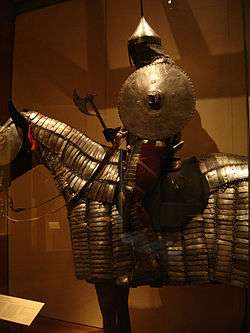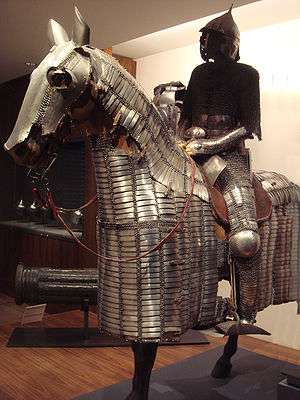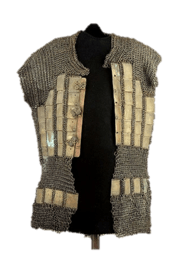Mail and plate armour
Mail and plate armour (plated mail, plated chainmail, splinted mail/chainmail) is a type of mail with embedded plates. Armour of this type has been used in the Middle East, North Africa, Ottoman Empire, Japan, China, Korea, Vietnam, Central Asia, Greater Iran, India, Eastern Europe, Philippines, Indonesia, and Malaysia.



Types
In Russia there are three known varieties of mail and plate armour. These were adopted from Persia, initially as Persian exports, and have Persian names.
- Behterets (Russian: Бехтерец), from Persian behter:[1] small horizontal plates arranged in vertical rows without gaps, joined by rings, and embedded in mail.
- Yushman (Russian: Юшман), from Persian jawshan:[1] long horizontal plates embedded in mail and resembling laminar armour (e.g. Roman lorica segmentata)
- Kalantar (Russian: Калантарь): square plates embedded in mail, very similar to the Japanese karuta tatami-do. The major difference is that kalantar are not sewn to a cloth backing as Karuta tatami-do are.
According to Bobrov[2] the first mail and plate armor appeared as cuisses in the Middle East, and were imported by the Golden Horde. Persian miniatures of the first half of 15th century show different combinations of mail and plate armour with lamellar armor and brigandines sometimes worn with a single round mirror plate as breast re-enforcement. The first representation of mail and plate armour as body protection is shown in Persian miniatures, which show mail and plate armour composed of relatively large plates, worn with laminar pauldrons and skirt (formed from long, horizontal plates), re-enforced by a large round mirror plate. The first representation of classic mail and plate armour (without lamellar elements) can be seen in Baghdad's miniature which dates from 1465. From the end of the 15th century mail and plate armour began to fully replace lamellar armours. The main difference between eastern European (Russian and Polish) and Oriental mail and plate armor (according to Bobrov) is that eastern European versions usually do not have sleeves, while Oriental versions have sleeves (the forearms were protected by vambraces). In a heavy version these sleeves have embedded plates, and a light version (more widely used) has sleeves entirely made from mail.
In Kitab al-Durra al-Maknuna (The Book of the Hidden Pearl) Jābir ibn Hayyān describes mail and plate armour for use in armours (jawasin), helmets (bid), and shields (daraq).[3]
In Japan mail and plate armour is called "karuta", small square or rectangular rawhide or metal plates with the gaps between them filled with mail.[4]
The first known use of iron plate mail in Korea was used by the Gaya Confederacy between 42-562 AD. A large number of iron and steel artifacts, including iron armor, iron horse armor such as helmets and bits, and smaller iron ingots (often used as money), have been found in the Daeseong-dong tombs in Gimhae. Gimhae (김해, 金海) literally means, "Sea of Iron," as if the city's name symbolizes the abundance of iron in the area. Surviving examples are currently on display at the Gimhae National Museum in South Korea. [5] The later Korean version of this armour is known as gyeongbeongap (경번갑/鏡幡甲). The most famous general who used this type of armor was General Chonji.
Gallery
- Japanese mail and plate armour in the form of a karuta tatami-do
- Indian (Mughal) riveted mail and plate coat zirah bagtar. Armour of this type was introduced into India under the Mughals.
- Ottoman (Turkish) mail and plate armor from the Topkapi Palace.
 Indian Sindh mail and plate armour.
Indian Sindh mail and plate armour.- Coat of mail with horn plates, Philippines (Moro people), 1800s - Higgins Armory Museum
 Persian (Iran) mail and plate armour dating from 1450, the New York Metropolitan Museum of Art.
Persian (Iran) mail and plate armour dating from 1450, the New York Metropolitan Museum of Art. Ottoman Mamluk armour circa 1550
Ottoman Mamluk armour circa 1550

- Georgian parade armour with golden plates

See also
- kote - Japanese bracers which were often made from plated mail sewn to cloth backing
- pl:Bechter moskiewski (Muscovy Mail-and-Plate) - Russian type of mail and plate armour
- Tatami-do - Japanese type of mail and plate armour
- Baju Lamina - Indonesian type of mail and plate armour
- de:Moro-Rüstung - Philippine type of mail and plate armour
- Mail (armour)
- Splinted armour
- Lamellar armour
References
- Leonid A. Bobrov "Iron hawks from the territory of Maveranahr" (sets of the defensive equipment of the warriors of the Middle Asia and the neighbouring territories in 16th–17th centuries)
- Леонид Бобров "Защитное вооружение среднеазиатского воина эпохи позднего средневековья" (Leonid Bobrov "Panoply of a Late Medieval Central Asian Warrior") Archived 2007-09-27 at the Wayback Machine
[http://www.kyrgyz.ru/bbr/bobrov_03.html illustrations of different kind of mail and plate armour - Ahmad Y Hassan, The Colouring of Gemstones, the Purifying and Making of Pearls, and Other Useful Recipes
- Ian Bottomley & A. P. Hopson, Arms and Armor of the Samurai: The History of Weaponry in Ancient Japan, pp. 88 & 91.
- Pak, John. "'Sea of Iron,' Gimhae embraces Gaya history". www.korea.net. Retrieved 14 April 2015.
External links
| Wikimedia Commons has media related to mail and plate armour. |